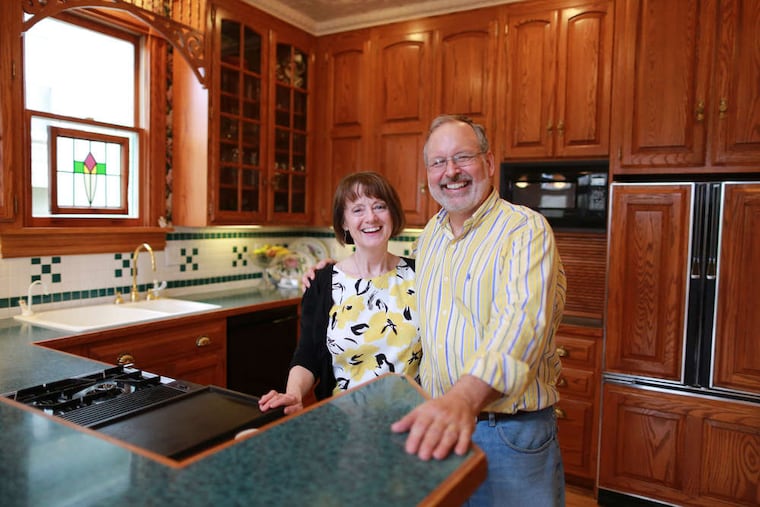Do-it-yourself Victorian a 34-year project
Bruce and Sylvia Wilson restored their 1891 home in Merchantville, the neighborhood's "great white elephant," and transformed it into one worthy of the local historical architecture tour. And they did it all with a bit of financial creativity.

Bruce and Sylvia Wilson restored their 1891 home in Merchantville, the neighborhood's "great white elephant," and transformed it into one worthy of the local historical architecture tour. And they did it all with a bit of financial creativity.
Over 34 years, they completed exterior and interior renovations on a budget, ripping off siding, repainting, wallpapering, designing and even carving architectural elements themselves for the house, purchased for $52,500 in 1980.
Outside contractors were hired only for a full kitchen demolition, a third-floor bathroom conversion, and heating/air conditioning work.
"We blindly and enthusiastically bought a three-story, seven-bedroom 3,600-square-foot Victorian home," said Sylvia Wilson, a schoolteacher.
When they bought in 1980, interest rates were 15 percent. They refinanced the house over the decades to pay for redos such as the kitchen, which cost almost the same as the property itself.
"Each time we refinanced, it coincided with a big project," said Bruce Wilson, a sociologist and education researcher.
Underneath layers of aluminum siding, InsulBrick and generations of paint, the Wilsons found original clapboard wrapping the first floor, cedar shingles around the second floor, and a tongue-and-groove design for the original dormer on the third floor. Aluminum from the siding was recycled at a Camden junkyard in exchange for about $1,000, which covered the cost of paint.
A neighbor lent them a 1930s photo of the house's original street-facing front with wooden finials on top, and the Wilsons had their roadmap.
John Crosby Freeman, author of numerous books on Victoriana, described the Wilson home as "a familiar American house type, which never went out of fashion in the 19th century, lovingly given a general Gothic Revival makeover by extenuating the proportions of the sides and massive central cross-gables projection on the front, and emphasizing its verticality with folk medieval half-timbering and what would have been called the Tudor style."
He consulted on the exterior, selecting paint from Sherwin Williams' Heritage Colors, Authentic Exterior Colors for American Buildings, 1820-1920.
One room at a time, the Wilsons rehabbed the first-floor bathroom (installing a pull-chain Victorian-era toilet, of course), and put in a $50,000 kitchen with floor-to-ceiling wooden cabinets, spandrels, shoe and cap moldings, and a dining room with original chandeliers, plaster moldings and rich colors Bruce researched to maintain the period feel. He located woodturners in Old City to reproduce finials or brackets, and researched specific planing knives used to carve Victorian-era door frames, finding a Philadelphia craftsman who used the blade.
For period furnishings, they never paid full price. "We had to fill the whole house, and we didn't have the money for furniture," Sylvia said. She snagged a fireplace mantel at a flea market for $500, saving thousands. She and Bruce stripped and sanded the paint and refinished the mantel, then stripped and sanded the second-floor family room.
For art, they hung sepia-toned photos of family and quilts Sylvia stitched. She also reupholstered some of the furniture.
They converted a third-floor bedroom into a bathroom, and created a master suite with 20-foot ceilings that borrowed height from the attic.
One afternoon, Bruce Wilson stumbled across workers ripping up red bricks on Independence Mall laid 20 years earlier for the Bicentennial but damaged by tree roots. He persuaded the park superintendent to donate the bricks.
"We dragged the boys out one Sunday morning, loaded up the minivan . . . made a few trips, and laid them in the back patio," Sylvia Wilson said. "Our sons still say we're crazy!"